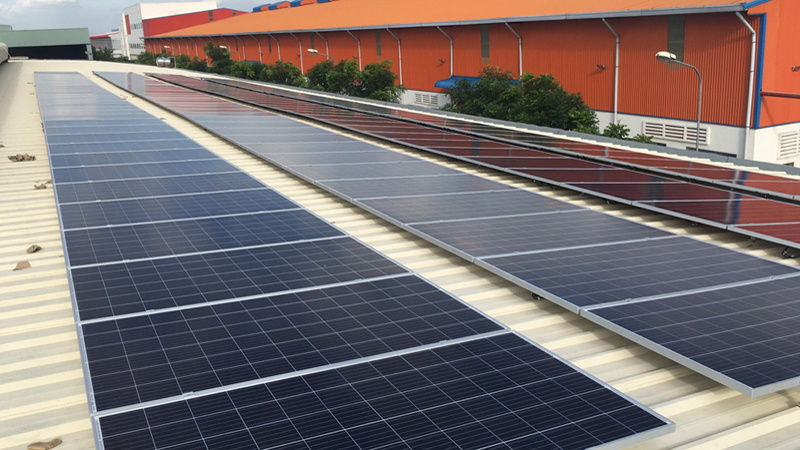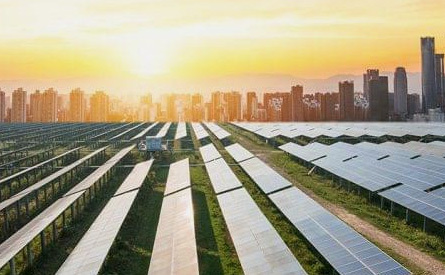Green,Innovation,Intelligent, Sharing
2022-05-18
The rise of China's photovoltaic industry in ten years
Not long ago, Wang Zhigang, Minister of Science and Technology, at a series of press conferences on the theme of "China's Decade", introduced that among China's scientific and technological innovation achievements in the past decade, solar photovoltaic is impressively listed, and it is an industry that ranks among the top in the world.
It took less than 10 years for China's photovoltaics to go from "three heads out" and being controlled by others, to firmly occupying the top spot in the world's photovoltaic industry and becoming China's business card in the new era. 10 years may not be too long for the development of an industry, but it means a lot of stories and experiences for the emerging industry of photovoltaics.
Among them, technological innovation is an important force that cannot be ignored.
Ten years of hard work
From being controlled by others to being a global leader
Time goes back to 2012. The end of the world predicted by the Mayans did not come true. However, for the newly emerging Chinese photovoltaic industry, the "double-reverse" in Europe and the United States was a big stick, but all practitioners experienced a real experience. A thrilling "Doomsday Crisis". At that time, China's photovoltaic industry, where raw materials, markets, and core technologies were all controlled by others, ushered in the "darkest moment". Under the strong wind and rain, the industry grieved everywhere, and the photovoltaic industry also fell to the bottom.
How to do? The surviving photovoltaic enterprises and active and promising national authorities have begun to realize that in order not to be "stuck" by others, the "life gate" of the core technology, industrial chain and supply chain must be firmly grasped in their own hands. As a result, China's photovoltaic industry has embarked on a tough road for ten years.
On the one hand, the government has introduced relevant industrial policies, from capital to market, from finance and taxation to land, quickly creating a policy environment that is conducive to the development of domestic industries. In the following years, policies such as kWh subsidy, leader plan, household photovoltaics, green certificate trading and other policies have appeared successively, paving the way for the development and growth of the photovoltaic industry.
On the other hand, Chinese photovoltaic companies have also "remembered the pain" and set off a wave of scientific and technological innovation. Companies such as LONGi, Jinko, Tongwei and GCL, which were still "rising stars" at that time, continued to increase investment in technological innovation. Among them, LONGi has always adhered to the business philosophy of "do not lead, do not expand production, do not get stuck, do not intervene", and continuously increase investment in scientific research and technological innovation. Manufacturing enterprises in various supporting links have also sprung up. In just a few years, the entire PV industry chain has achieved rapid development.
Taking the stringer of the component end equipment as an example, before 2013, all the stringers purchased by the photovoltaic factories in China were from German TT (Teamtechnik), German Somont (Germany), American Komax (Komax), Spain Foreign equipment manufacturers such as Gorosabel, Spain's Mondragon, Japan's Toyama, Japan's NPC and South Korea's HANWHA occupy the absolute market share of the domestic solar cell string welding equipment industry. However, after only 3 years, the market structure has been very different. Under the challenge of a number of domestic stringer companies such as Autowei and Pioneer Intelligence, 95% of stringers in the new production lines in the Chinese market have become domestic equipment. Up to now, the former industry leaders such as Komax in the United States, NPC in Japan, and Toyama have withdrawn from the stringer market due to high product prices, while German Emperor Mu has withdrawn from the Chinese market and is no longer competitive.
The above examples abound during this decade. Chinese enterprises live up to expectations, speak with strength, produce scientific research results one after another, and build a solid and stable supply chain step by step. According to the data of China Photovoltaic Industry Association: by the end of 2015, in the four core links of photovoltaic manufacturing - polysilicon, silicon wafers, cells and modules, the output of domestic enterprises ranked first in the world, accounting for 48.5% of the global total. %, 79.6%, 62.6% and 76.1%.
At the same time, China has also mastered the 10,000-ton-level improved Siemens method polysilicon production technology, and the fluidized bed method polysilicon production technology has also begun industrial production. The industrialization efficiency of monocrystalline and polycrystalline cells reached 19.5% and 18.3% respectively, leading the world.
In terms of special equipment for production lines, from silicon material production, silicon wafer processing, cell and module production, to photovoltaic industry chain-related testing equipment, simulators, etc., we have complete supply capabilities, and some products have even achieved varying degrees of export.
A decade of innovation
Cost reduction and efficiency increase throughout
Throughout the entire process of photovoltaic cost reduction and efficiency improvement, there is a main line running through it, that is, technological innovation promotes the industry's cost reduction and efficiency improvement. This is not a buzzword or a theoretical question, but a choice made by the market. In the past ten years, there have been "route disputes" in many aspects of the photovoltaic industry, from crystalline silicon to thin film, from polycrystalline to monocrystalline, from centralized to string inverters... But these competitions are fundamental , are to reduce costs and increase efficiency, improve the economy and competitiveness of photovoltaic energy, and the improvement of battery conversion efficiency plays a key role in the overall situation, becoming the "main track" for the transformation and upgrading of the photovoltaic industry.
The time is reset to 2015. This year, photovoltaics gradually got rid of the haze of the past, and with the strong support of national policies, finally ushered in a golden period of development. Photovoltaic companies that have stepped out of the trough have begun to continuously promote technological upgrades based on market demand, focusing on performance and cost.
During this period, the market demand and technology development line were still dominated by polycrystalline silicon. Under the technical research of many first-tier manufacturers such as JA Solar, Jinko, Trina, Canadian Solar, light trapping and surface passivation, high efficiency New technologies and processes such as polycrystalline ingots and wet black silicon are emerging one after another. Under the comprehensive support of these technologies and processes, the conversion efficiency of polycrystalline cells has broken through the theoretical limit of 20% previously recognized by the industry.
But this is far from enough. The market needs technologies and products with higher conversion efficiency, in order to achieve the goal of photovoltaic parity on the grid as soon as possible. At this time, the "Photovoltaic Leader" program came into being. This top-level plan, which aims to promote the transformation of the photovoltaic industry from pursuing scale expansion to focusing on quality and efficiency, has become a "testing ground" for the upgrading of photovoltaic technology.
Driven by it, various advanced technologies began to compete for technological innovation and upgrading. Among the three batches of front-runner bases that have been launched successively since then, technologies such as PERC, PERC double-sided, heterojunction, and MWT have appeared one after another. At the same time, the market has also given an answer to the choice of the single-polysilicon technology route - the cost-effective single-crystal technology stands out and gradually becomes the "leader" base and the main force in the entire market application.
Prior to this, although the conversion efficiency of monocrystalline cells was higher and the development space was larger, they were widely criticized due to cost issues, and photovoltaic owners and EPC companies did not have enough understanding of the concept of LCOE, so the cheap polycrystalline products It occupied an absolutely dominant position for a period of time, so that in 2013, during the "double-reverse" period in Europe and the United States, the single crystal technology route was once faced with the crisis of being marginalized.
"Crisis and opportunity", the turning point also appeared in this period. In 2014, LONGi took the lead in overcoming the problem of industrialization of RCZ single crystal growth technology, increasing the output of silicon rods from 60kg/crucible to 1500kg+/crucible. The application of this technology has increased the crystal pulling speed by more than 80%, the cost gap per kilogram between monocrystalline silicon rods and polycrystalline ingots has rapidly narrowed, and the huge cost gap between monocrystalline and multicrystalline ingots has also rapidly narrowed. The rapid development of crystal provides an opportunity. In 2020 alone, this technology will save about 13.6 billion yuan in costs for China's photovoltaic industry.
During the same period, another key technology related to the future of single crystal, diamond wire cutting technology, was also the first to achieve localization in LONGi, which not only broke the monopoly of overseas manufacturers on diamond wire technology, but also solved key problems through close upstream and downstream joint technology. With the introduction of technology, high-quality and low-cost diamond wire was quickly developed, which quickly reduced the supply price of diamond wire to about 0.3 yuan/meter, saving the industry 30 billion yuan in costs every year, and thoroughly laid the foundation for single crystal to lead the industry pattern. .
Both technologies were obtained by LONGi with the belief of "breaking the boat and sinking the boat". From this point of view, LONGi has almost single-handedly changed the monopoly pattern. Someone in the industry once said without hesitation that without LONGi's technical focus and continuous promotion of monocrystalline technology, and relying on the natural development of the market, it is difficult to say how far the monocrystalline technology route will develop, and the speed of photovoltaic parity may not be as fast as it is now. So fast.
At the same time, the introduction of PERC cell technology has made the cost reduction advantage of single crystal technology more obvious. Aixu, Tongwei, Jinko, JA Solar and other battery module companies have turned to mono and PERC technology, making the value of mono modules further recognized by the market.
During this period, LONGi, which has just entered the field of batteries and components, once again played a key role. Through in-depth research on the mechanism of light decay jointly with partners such as the University of New South Wales in Australia, LONGi solved the problem of high initial light decay of single crystal PERC in one fell swoop, and opened LIR technology to the industry.
The next story is well known. The Pandora's box of monocrystalline PERC technology has been opened. With the continuous efforts of many companies in the industry, new technologies and processes such as double-sided, half-chip, MBB, shingled, and multi-busbar are emerging. , so that the single crystal efficiency curve continues to climb, and the cost also drops again and again.
By the end of 2017, the price of monocrystalline modules was almost the same. So far, the advantages of single crystal no longer need to be proved through various parameter assumptions and complex calculations, which will have an intuitive and strong impact on the market, and complete the counterattack against polycrystalline in one fell swoop.
Throughout this process, the market is looking at the cost advantage brought by technological iteration, which is the key to the counterattack of single crystal technology, and is also the driving force behind the reduction of photovoltaic costs by nearly 80% in the past 10 years. source.
Ten years of transformation
From subsidy to parity
In the past ten years, the photovoltaic industry is gradually getting rid of its dependence on policies and subsidies while pursuing technological progress. Amazing transformation. May 31, 2018, was undoubtedly a watershed in this historical transformation. On this day, the National Development and Reform Commission, the Ministry of Finance, and the National Energy Administration jointly issued the "Notice on Matters Related to Photovoltaic Power Generation in 2018" (called "531 New Deal" in the industry), reducing the scale of photovoltaic power generation in the second half of the year to one-third of the original. One or less, and requires immediate implementation on June 1. The intensity and speed of policy subsidy reduction far exceeded expectations, forming an unprecedented impact on the photovoltaic industry at that time.
Prior to this, benchmark electricity prices and gradually decreasing subsidy intensity effectively supported the large-scale development of the industry, but at the same time, higher on-grid electricity prices and power generation costs also restricted the further development of the photovoltaic industry. In 2017, the average on-grid price of photovoltaics was still as high as 0.94 yuan/kWh, and the power generation cost was also 0.5-0.65 yuan/kWh. Compared with other forms of power generation, the price was not competitive.
Fortunately, China's photovoltaic industry has once again withstood the test. This "adult ceremony" that came early has accelerated the withdrawal of backward production capacity in the industry. Photovoltaic companies have accelerated the pace of technology research and development and innovation. The pace of "cost reduction and efficiency improvement" in the industry has further accelerated. Many key technologies will be implemented within one year of policy implementation. get a breakthrough.
For example, in the module battery sector, according to incomplete statistics from industry media: at least 20 world efficiency records will be created in 2019, including not only PERC products that have become mainstream in the market, but also heterojunction, TOPCon, perovskite, etc. Cutting-edge technology for large-scale industrialization. During the period, LONGi set a world record of 24.06% front-side conversion efficiency of monocrystalline bifacial PERC cells, breaking the previously recognized limit of 24% in the industry.
As time comes to 2020, photovoltaics will usher in a new round of historic development opportunities. The successive proposals to achieve carbon peaking by 2030, achieve carbon neutrality by 2060, and build a new power system with new energy as the main body have endowed photovoltaics with greater historical responsibility. Focusing on the implementation of the goals, the state has intensively introduced a number of new policies, which not only established the direction and strategic goals for the transformation of wind power and photovoltaics to the main energy status, but also completed the complete package from top to bottom once again, creating a good policy environment for the future development of China's photovoltaic industry. .
Photovoltaic has thus entered a new era of historical development. At this stage, as one of the new entities, photovoltaics must not only achieve continuous technological progress, continuous cost reduction, continuous improvement of efficiency, continuous enhancement of competitiveness, and comprehensive realization of non-subsidy parity or even low-cost market-oriented development, but also accelerate the solution of key technological innovations. , high proportion of consumption, industrial chain supply chain security, stability and reliability and other key issues.
For photovoltaic companies, innovation in photovoltaic power generation technology will remain a key factor in addressing these challenges. As Wang Bohua, honorary chairman of the China Photovoltaic Industry Association, said: "In the new era, the photovoltaic industry needs to constantly cultivate itself, continue to innovate and develop, reduce costs and increase efficiency, and coordinate the development of the industry, so that photovoltaics can truly become the main force of the new power system. "
In short, looking at the development of China's photovoltaic industry in the past ten years, it can be concluded that technological innovation is the core driving force for the continuous advancement of China's photovoltaic industry.
Looking forward to the future, from the perspective of carbon peaking and carbon neutrality, by 2030, the world's newly installed photovoltaic capacity needs to reach 1500GW-2000GW in order to form an effective support for the global energy transition. Therefore, photovoltaic companies or industries should try their best to protect themselves from external influences, return to the main track of battery efficiency improvement, increase investment in research and development of new battery materials and new technologies, do a good job in technological innovation, and be committed to reducing costs and increasing efficiency and improving The competitiveness of the photovoltaic industry promotes the large-scale application of clean energy. This is the top priority of the current and future development of China's photovoltaic industry.
We believe that if China's photovoltaic industry can insist on doing this, the next decade, China's photovoltaic industry will be a different scene.
Related News

Contact Information
 sales@esolarstar.com
sales@esolarstar.com
 0086-13929199660
0086-13929199660
 www.hengzhouenergy.com
www.hengzhouenergy.com
 No. 105, building 10, Hekou Wenta Road, southwest Street, Sanshui District, Foshan
No. 105, building 10, Hekou Wenta Road, southwest Street, Sanshui District, Foshan
Copyright © 2022 Guangdong Hengzhou Energy Technology Co., Ltd All Rights Reserved. Powered by:www.300.cn SEO

 Language
Language 







 sales@esolarstar.com
sales@esolarstar.com

 Whatsapp
Whatsapp
 Message
Message